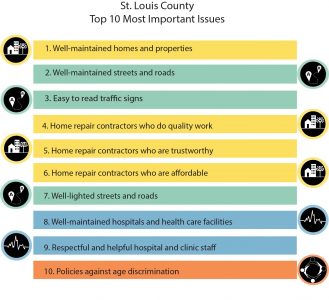Surveying Older Adults



In order to best serve older adults and increase the age-friendliness of your community, it is important to ask for and record information from residents on a variety of topics. Collecting resident input provides valuable insight on how the public feels about community issues. This information can guide strategic decisions and priorities for your community.
Engaging the community strengthens civic-resident relationships, promotes transparency, and helps inform municipal leaders on resident preferences. Surveying residents provides municipal leaders and staff with baseline information about the community. Furthermore, consistent data collection over time provides insights into shifting preferences and trends within a community.
Stratify Data by Age
If you already collect information on community issues from your residents, consider stratifying the data you receive by age groups or generations. This allows you to more deeply understand differences and needs among age groups within your community. Using generational categories (Silent and Greatest, born before 1945; Baby Boomer, born between 1946-1964; Gen-X, born between 1965-1979; Millennial, born between 1980-2000) is an easy place to start.
Surveying of Older Adults by Topic
You may also want to gather information from older adult residents on a specific topic. AARP’s website is a rich resource for how to survey older adults on a variety of topics (http://www.aarp.org/research/). The Livable Communities section of the website provides detailed information on the various topics. Additionally, it includes Livable Communities Surveys and Neighborhood Surveys completed by AARP.
These surveys model potential topics and questions that can be adapted for most communities. For example, some survey questions center around whether or not resident’s feel that they are likely to retire within or outside of your community. If retention of older adult residents is a priority of your community, you will need to understand how many individuals believe your community is a place they intend to retire. If many do not want to retire in your community, it may be that there are desirable amenities you are missing. From survey results, you can begin to plan how to gather more detailed information from residents.
QUESTION BANK: SURVEYING OLDER ADULTS
Below is a list of standard age-friendly questions, by focus area, to consider including in your next community survey. Survey questions can be developed many ways. You can develop yes/no questions, use a Likert scale, or give multiple choice answers. AARP surveys often ask how important an amenity is to a resident and whether or not that amenity is available within their community. The questions below can be modified to best serve your survey needs.
Health & Wellbeing:
Do you feel there is a range of health services available to you in your community?
Do you feel information about health and support services is clear and accessible to you?
Do you feel there is a good understanding for how to request services as a senior in your community?
Do you feel delivery of health and support services is coordinated and simple?
Are health and social services conveniently located and accessible by all means of transportation?
Are home care services including health, personal care, and housekeeping available and accessible to you?
Mobility & Accessibility:
Is information about transit routes, schedules, and special needs facilities complete and accessible for you?
Are transit stops and stations conveniently located?
Are transit stops and stations safe?
Are transit stops and stations accessible?
Are transit stops and stations clean, well-lit and well-marked?
Do transit stops and stations have adequate seating and shelter?
Are roads well-maintained with covered drains and good lighting?
Are sidewalks well-maintained?
Do sidewalks have good lighting?
Are driver education and refresher courses available to you?
Is outdoor safety promoted by good street lighting?
Is outdoor safety promoted by police patrols?
Is outdoor safety promoted by community education?
Are sidewalks free of obstructions?
Are sidewalks reserved for pedestrians?
Social & Civic Engagement:
Do you feel there is a range of options to volunteer in your community?
Do you feel there are flexible and appropriately paid job opportunities for older people in your community?
Do you feel that you are encouraged and able to participate in the development of policies relevant to your life?
Do you feel that there is a wide variety of activities offered to older adults?
Do you feel the activities in your community appeal to a diverse population of older adults?
Are events held at convenient times for older adults?
Are activities affordable with no hidden or additional participation costs?
Safe & Attractive Neighborhoods:
Do you feel that enough affordable housing is available in your community?
Do you feel that housing is available in safe areas?
Do you feel that housing is close to services and the rest of the community?
Do you feel enough affordable home maintenance and repair services are available to you?
Do you feel safe in your home?
Do you feel safe in your community outside of your home?
Are public spaces clean and pleasant?
Are public restrooms sufficient in number?
Are public restrooms clean?
Are public restrooms well-maintained?
Communication & Information:
What is the best, most effective way for your government to get information to you? (email, website, phone, mail)
Is information available to you in a coordinated and centralized place?
Can you easily access information you need about your community?
Is public access to computers and Internet available to you in public places including government offices, community or recreation centers, and libraries?
Main target group: Older people in general
Other target group(s): 45 and older
Sector(s): Education, Health, Housing, Information and communication, Labor, Long-term care, Social protection, Transportation, Urban development
Desired outcome for older people:
Meet their basic needs